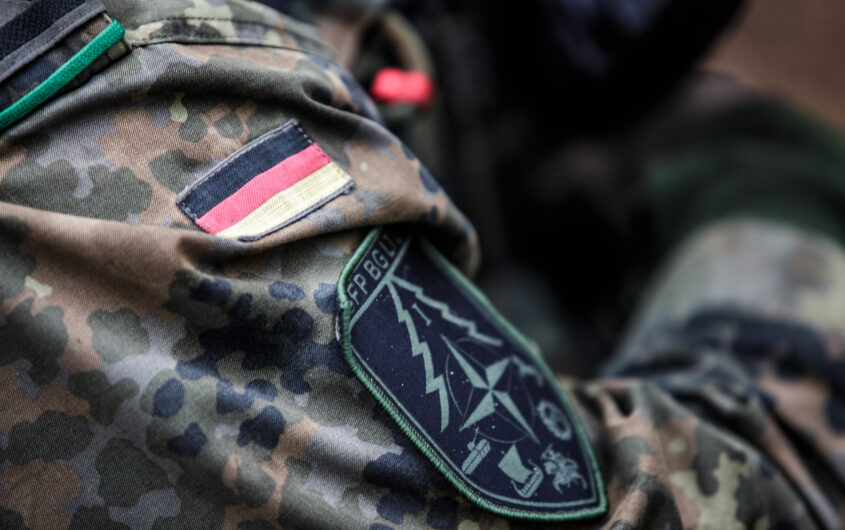
NATO via Flickr
Germany’s Military Deployment to Lithuania

Jakob Grein
Georgetown University
Jakob Grein formerly worked at the European Commission’s Climate, Infrastructure and Environment Executive Agency (CINEA) and was a Halle Foundation intern the American-German Institute. He is currently a Graduate Student in Security Studies at Georgetown University where he focuses on European security and energy security.
Rough Terrain Ahead for the Bundeswehr
The Eurasian lynx is the largest wild cat native to Lithuania. Soon, this cat will be joined in its forested habitat by much larger, louder, and more dangerous felines. The German Leopard tanks and Puma infantry fighting vehicles set to prowl the countryside of the Baltic nation constitute part of a novel deployment of a German Bundeswehr brigade to Lithuania. This article will survey this deployment and investigate the difficult road ahead for the German armed forces in the Baltics.
The Bundeswehr Goes Abroad
In the wake of the full-scale invasion of Ukraine and a reinvigoration of defense and security policy in Germany (the Zeitenwende), Berlin has sought not only to increase its commitment to its own defense needs but also to live up to its responsibilities within NATO as the largest and most prosperous European member of the alliance. The Russian invasion of Ukraine has vividly demonstrated that European countries need to take their defense seriously and that the threat from the east is real and unlikely to disappear. To meet this challenge, NATO allies agreed on concrete steps to strengthen the eastern flank. At the Vilnius summit in 2023, NATO partners reaffirmed the need for strengthened deterrence and increased military deployments, especially in the Baltics. This German commitment—the first-ever permanent basing of German troops abroad since World War II—is one result.
This deployment marks a major change in Berlin’s policy. A permanent combat deployment in Lithuania departs significantly from the NATO-Russia Founding Act of 1997, which ruled out permanent substantial basing of NATO troops on the eastern flank. The original terms of the agreement were understood at the time to apply to combat forces larger than the size of a brigade. One could thus make the argument that the German deployment just converges on this limit and does not violate the Founding Act. Germany, for its part, is unlikely to explicitly repudiate the Founding Act. However, the permanence and troop number are such a significant shift that one should nonetheless understand the project of the Lithuania Brigade as a strategic and political abandonment of the 1997 agreement, which itself is a relic from a time of relative comity between Russia and the West.
The Lithuania Brigade is a case of Germany surging ahead and establishing a precedent that others may follow.
This commitment, reinforced by Defense Minister Boris Pistorius during a visit to Vilnius, forges a path ahead for NATO’s defense on the eastern flank with Germany in a leading role. This is groundbreaking in so far as it goes beyond what other Allies have done on the eastern flank, specifically Canada in Latvia and the United Kingdom in Estonia. The planned deployment fits neatly into the strategic goals of NATO to bolster deterrence. Many allies share the strategic view that more deterrence is needed on the eastern flank. At the 2022 NATO summit in Madrid, the allies agreed to far-reaching measures to protect countries like Estonia, Latvia, and Lithuania. However, the reaction to the altered security landscape has been different in each NATO member state, and the pace at which change is implemented certainly diverges. The Lithuania Brigade is a case of Germany surging ahead and establishing a precedent that others may follow.
The Deployment
Germany already leads a battlegroup in Lithuania as part of the NATO enhanced Forward Presence (eFP); however, these combat elements will be significantly expanded under the current plans. The Bundeswehr will deploy 4,800 soldiers and 200 civilians, a full heavy combat brigade, to Lithuania. The brigade is scheduled to be fully combat-ready by 2027. An entirely new base, located on a former Soviet airstrip in the Rūdninkai Forest roughly forty kilometers south of Vilnius, is being constructed to house the German troops. Once it is fully operational, the brigade will consist of the 122nd Armored Infantry Battalion, the 203rd Tank Battalion, as well as the currently deployed elements of the multinational NATO eFP battlegroup. This latter combat formation is already under German command, but the heavy brigade will significantly bolster the command and control elements present in Lithuania, not least due to an increase in command staff based in the country. This deployment will also dramatically increase the combat potency of the NATO presence in Lithuania. A full German tank battalion consists of forty-four Leopard tanks. The 122nd is comprised of four companies, each with 12 Puma infantry fighting vehicles. Both combat units have additional supporting elements attached. Once the brigade is fully deployed, north of 100 combat vehicles will be permanently stationed in the Baltic country. The German army command has affirmed that the Brigade Lithuania has priority in receiving the latest variants of the Bundeswehr’s main battle tank, as some of its tanks were donated to Ukraine. The heavy combat brigade will, next to its core infantry and armor elements, include various support detachments such as artillery, logistics, engineering, medical, and reconnaissance. This project is quite literally groundbreaking for Germany. While foreign deployments such as in Kosovo, Afghanistan, and Mali are not new, the scale and permanence of this endeavor are unparalleled for the Bundeswehr and Germany. German Minister of Defense Pistorius labeled this endeavor the “beacon project of the Zeitenwende,” and it will certainly serve as one of the yardsticks—along with other procurement and reform efforts—to judge the success or failure of Germany’s “sea change” in security and defense policy announced by Chancellor Olaf Scholz on February 27, 2022.
Rough Terrain Ahead
The German brigade would constitute a significant upgrading of the currently 1,600-strong NATO eFP deployment and certainly be much more than just a NATO ‘tripwire.’ It symbolizes a shift away from an approach based on strategic depth and surging forces when necessary to a strategy based on forward defense. Indeed, Chancellor Scholz said during a recent press conference with Estonia’s Prime Minister Kaja Kallas that “[Germany] is ready to defend every square centimeter of NATO territory against attacks.” Yet these words alone do not guarantee success.
As with most other military deployments, this project comes with significant challenges. First and foremost is the cost of this planned permanent stationing. Germany and Lithuania have agreed to split the cost, and Vilnius will cover construction and infrastructure expenses while Berlin will shoulder maintenance and other running costs. However, this plan cannot be implemented by just shipping existing Bundeswehr units to Lithuania. Indeed, due to equipment donations to Ukraine and decades of structural underinvestment, much of the kit needed for this permanent deployment still needs to be procured. The best example is the aforementioned Leopard main battle tank, where the latest version, the Leopard 2A8, is currently filling the gaps left by the delivery of older Leopards to Ukraine. Defense Minister Pistorius recently announced the order of an additional 105 Leopard 2A8s; it will take time for these tanks to be delivered. Furthermore, other equipment gaps exist. More efforts are necessary to fully furnish the Lithuania Brigade–and the Bundeswehr as a whole. Furthermore, the facilities needed for the 5,000 soldiers and civilians also still need to be constructed; as a permanent base, these facilities will include much more than just rudimentary barracks. The base will include housing for soldiers and their families, schools, a kindergarten, and shopping opportunities. Lithuanian Colonel Rimantas Jarmalavičius, tasked with overseeing the efforts on the Lithuanian side, joked that there might even be a Lidl (a popular German supermarket).
All in all, the German Ministry of Defense (BMVg) estimates that this stationing will cost €11 billion. The BMVg has estimated that €4 billion is needed for equipment purchases, and €6 billion is foreseen for other investments. On top of these upfront costs, running costs of €800 million to €1 billion annually are expected. There are additional perils associated with these expenses, which for German standards are extraordinarily high. While Germany in 2022 earmarked a special €100 billion fund for defense procurement, the Sondervermögen, almost all of this money has already been allocated to various projects in the German armed forces, and the anticipated costs of the Lithuania Brigade are not covered by this special fund. Boris Pistorius has asked for an additional €6.5 billion to be added to the defense budget in the upcoming budget year; however, this has been met with stiff resistance from Finance Minister Christian Lindner. According to the latest agreement between the coalition parties, the defense budget in 2025 is set to increase by only €1.2 billion, falling far short of the needed expansion. Boris Pistorius called this frugal decision “annoying” and many other politicians have stressed the need to renegotiate.
Apart from budgetary woes, the internal jockeying around the Lithuania Brigade raises questions. According to some reports, the top brass of the Bundeswehr and even some high-ranking politicians in Berlin were caught off guard by Boris Pistorius’ announcement in Vilnius. Within the Ministry of Defense, there appears to be some friction about the implementation of the Lithuania Brigade project, and the staff tasked with this mission has raised concerns, particularly about the quick pace at which the deployment is supposed to happen. Already in November 2023, the Inspector General of the Heer (Ground Forces) Alfons Mais addressed a letter to the Ministry of Defense lamenting materiel shortages and that the relocation of Germany’s most modern equipment to Lithuania would worsen the situation for the Bundeswehr in Germany. In addition, the Bundeswehr has also been plagued by personnel shortages, which further complicates the ambitious plans to achieve full deployment by 2027. The project to permanently position a heavy combat brigade in Lithuania is thus simultaneously an ambitious and timely flagship project while also being emblematic of systemic problems the Bundeswehr is facing.
Conclusions
Nonetheless, these obstacles have to be put into perspective. This is the first time Germany is undertaking such a foreign deployment. Germany, unlike the United States, still has to learn and establish procedures for this kind of military activity. A permanent deployment is fundamentally different from an exercise or a rotational stationing. And even for a superpower such as the United States, establishing a permanent base is not something that happens overnight; Ramstein was also not built in a day. Given the immense challenges and the fact that Germany is essentially starting from scratch, any effort must be evaluated with some caution. The lessons learned will undoubtedly be valuable going forward. As the war in Ukraine continues and Russian hostility shows no signs of abatement, NATO and Germany will need to be prepared for further measures on the eastern flank if the situation deteriorates. Such measures may include further permanent deployments by NATO forces. Here, the German initiative may serve as a template and provide other states with valuable information, such as what to expect and sources of uncertainty, which may ultimately increase their willingness to participate. In addition, if Germany does manage to successfully install a forward-deployed heavy combat brigade, it would serve as a potent signal to both the eastern NATO members and Russia that defense is being taken seriously by Germany and other allies.








